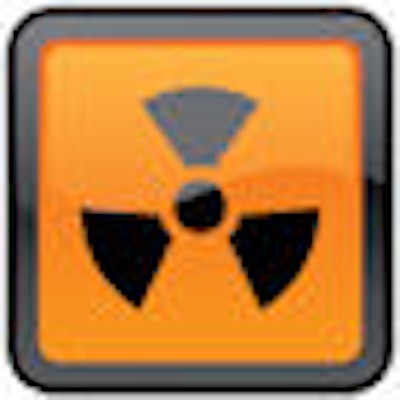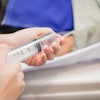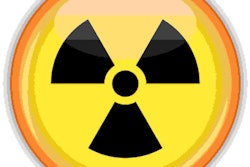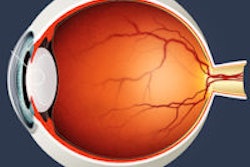
What's the latest on the risk to patients from medical radiation? It all depends on the exam and the patient, of course, but knowledge is evolving, and some newer evidence suggests higher risks from smaller doses, according to speakers presenting last Friday at a Washington, DC, symposium sponsored by the National Academy of Sciences.
The key step for radiologists is first to measure risk, according to Dr. Amy Berrington de Gonzalez, PhD, from the U.S. National Institutes of Health, who led a session on risk to close the 2011 Gilbert Beebe Symposium: Tracking Radiation Exposure From Medical Diagnostic Procedures.
De Gonzalez and colleagues at the National Cancer Institute (NCI) have been developing an advanced risk calculator that estimates risk for 18 specific cancers, she said. De Gonzalez is a senior investigator in radiation epidemiology at NCI.
With time and inclination, risks from radiation can already be calculated roughly from the Biological Effects of Ionizing Radiation (BEIR) VII report, but the calculator the NCI is developing goes beyond BEIR VII to incorporate newer studies and models, she said. For example, it includes brain cancer risk, which wasn't included in the BEIR VII report but is an important consideration for patients undergoing head CT.
"The key aspect of the calculator is that it calculates formal uncertainty," de Gonzalez said. "We know that there are all sorts of uncertainties involved in low-dose risk estimation. There are subjective uncertainties over how to transfer late risk models from the Japanese population to a U.S. population, uncertainties about the shape of the dose response at low doses, and statistical uncertainties in the model parameters."
The program uses Monte Carlo methods to come up with a range of risks, providing the highest and lowest potential risks from a given exam.
The NCI application will soon be available for research, and an online version is expected early next year, she said. In the meantime, there are plenty of simpler risk calculators available online.
Minimizing risk
In his presentation, Dr. David Brenner, director of the Center for Radiological Research at Columbia University in New York City, talked about radiation doses from exams and how to minimize risk.
Accumulating evidence reveals the enormous differences in risk between high- and low-dose exams, he said, and the big differences in risk between exams in children and adults. Different machines and usage patterns also contribute to major differences in radiation risk.
Among the approximately 25 million people who will receive some 80 million CT scans this year, the risk will vary widely. If one were to track them for the previous 25 years, Sodickson et al showed that half of the patients will have received more than 25 mSv, about 4 million will have received more than 100 mSv, and 1 million will have gotten more than 250 mSv, Brenner said.
Atomic bomb survivor data roughly correspond to what is known about population cancer incidence following radiation exposure, and although there aren't a lot of studies by which the bomb data can be confirmed, what is out there broadly supports those results, and more results are forthcoming, he said.
Examples include the Oxford Survey of Childhood Cancers, which, although controversial, found a significant increase in childhood cancer after in utero exposure of about 6 mGy.
"Within the CT dose range we do have an increase in risk; it's going to be a small increase in risk," and there is no direct epidemiological risk in lower-dose studies such as a chest x-ray or a mammogram, Brenner said. Epidemiological studies, mostly in children, are really just getting started, he said, though many studies are under way. But even so, cancer latency periods are long -- and cancer incidence rare enough -- to engender questions about whether the studies will be large enough to show anything.
Ultimately, the goal is to combine all of the epidemiological study results into an integrated risk model, but that goal is at least several years away, Brenner said.
For now, the indirect dose-based risk estimates are more practical, he said. These can be created by estimating the dose to each organ as a function of age, gender, and exam type. Estimates of age-, gender-, and organ-specific risks per unit dose (i.e., bomb survivor data transferred to a Western population) are applied, and the risk is summed for all organs. Uncertainties are high, at about a factor of three in each direction, he said.
"It's an indirect route, but it's all we have at this moment, and it's probably not too crazy because we do know that the risks from the atomic bomb survivors are real in the dose ranges we're interested in," he said. For example, a pediatric head scan is believed to confer a one in 1,000 lifetime risk of cancer.
"The general dogma is that we should be more concerned about children than adults," he said. Indeed, there is a dramatic fall-off in lifetime risk as a function of age and exposure, though that risk assessment may be evolving too.
And while the risks are small, they are almost certainly not zero, he said. Because the number of cancers that might develop from an imaging scan is so small, the risk-benefit ratio will typically favor the exam, but it's still important to keep the exam dose as low as feasible. Screening exams change the equation and are worthy of even more scrutiny, he suggested.
About one-fourth of all CT exams performed in the U.S. each year are medically unjustified, and although the risk is small, the long-term public health risk is real, making it important to reduce the incidence of unnecessary scans.
Going forward, a prudent two-pronged approach consists of the following:
- Reducing dose per scan through training, technology, and quality control
- Reducing unneeded scans through training and decision rules
There is increasing evidence that scans in middle age convey a higher risk than estimated in BEIR VII, per Shuryak et al (2010), he said. And because middle age is where most CT scans are occurring, this is worth considering.
"We need to think about people of all ages when we're thinking about minimizing risks from CT," he said.
Noncancer radiation effects edge higher
Dr. Kiyohiko Mabuchi, PhD, from the NCI's radiation epidemiology branch, discussed the noncancer effects of radiation, beginning with the Japanese bomb survivors, which constituted a huge group of 120,000 individuals followed since 1950 in the Life Span Study (LSS). The cohort has presented with a broad spectrum of diseases for investigation.
Currently, there are no models available for noncancer risks, de Gonzalez noted.
Three issues need to be addressed about noncancer risks, Mabuchi said, including types and diseases of concern, dose response in a low-dose range, temporal patterns of risk, and the modifying effects of age factors.
Four major categories of noncancerous diseases have been found to be significantly related to radiation dose, including stroke, heart disease, digestive diseases, and respiratory disease, Mabuchi said.
The latest LSS study data show that the overall risk of noncancerous diseases is small, on the order of 10% per Sievert, which is about one-fifth of the cancer risk. But the background rates of noncancerous disease are so high that if you look at the excess number of deaths from noncancerous disease, it's quite substantial, with two-thirds of the risk coming from cardiovascular disease, according to Preston et al, he said.
"So in terms of the magnitude, excess deaths from noncancerous diseases are pretty important," he said.
High baseline rates and low excess relative risk (ERR) rates mean that precise disease patterns are hard to pinpoint. But patterns are emerging, and research is showing that "the age and time and gender patterns for noncancerous disease are quite similar to what's being found for cancer," he said.
Using LSS data, Preston et al found an ERR per Gy of radiation dose of 0.11 for men and 0.17 for women, Mabuchi noted. And it's dose-dependent: For heart disease, Shimizu et al (2010) found an ERR of 0.14 for 0 Gy to 2 Gy, 0.18 for 0 Gy to 1 Gy, and 0.20 for 0 Gy to 5 Gy.
For stroke, the investigators found an ERR of 0.9, with possible upward curvature of the incidence for higher doses.
But "there is still much to be learned about risks from low doses," Mabuchi said. "As the follow-up from the Life Span Study continues, I think we will gain much more information, which will help us characterize the dose-risk response and other modifying effects."
A 2010 study by Japan's Health Protection Agency (HPA) examined the ERR associated with ischemic heart disease risk and radiation dose among various populations, including medical and nonmedical radiation sources.
The HPA's meta-analysis of the available data found "there is a statistical heterogeneity in the risk among different population studies possibly due to confounding among unmeasured lifetime factors including smoking, etc. This heterogeneity is diminished but not completely eliminated if allowance is made for end points like mortality versus morbidity, heart disease versus stroke, and possibly the effect of dose fractionation."
Altogether ERR is estimated to be about 9% per Gy (95% confidence interval: 0.07-0.12) in the presence of radiation causality of circulatory disease from exposures less than 5 Gy; the HPA's Advisory Group on Ionising Radiation (AGIR) in 2010 said it considered the evidence cause for radiation protection.
The International Commission on Radiological Protection (ICRP) followed this past April with a statement on tissue reactions that said that doses for complex interventional cardiac procedures could reach this level, making dose optimization a crucial step, Mabuchi said.
In digestive disease, Fujiwara et al found that the high ERR per Gy (0.5) was principally related to the high ERR (0.19/Gy) for liver cirrhosis. This disease was related to the exposed liver's reduced ability to clear hepatitis B and possibly hepatitis C, Fujiwara and colleagues said.
In respiratory disease, data showed that the high ERR per Gy (0.18) for respiratory disease was primarily related to the high ERR for pneumonia (0.19/Gy) among elderly bomb survivors. However, the excess deaths could be due to other debilitating diseases and misclassification of causes of death; therefore, more study is needed, they said.
Regarding other diseases, Yamada and colleagues found significant excess risk for noncancerous thyroid disease, cataracts, and chronic liver disease, but no dose response for hypertension, gastric ulcers, kidney stones, cholelithiasis, dementia, or glaucoma.
Nakashima et al in 2006 found long-term associations between radiation exposure and cortical cataracts (0.6 Gy), as well as posterior subcapsular cataractopacities (0.7 Gy), at lower radiation levels than previously thought, Mabuchi said. Postoperative data showed that the best threshold estimate for cataracts is around 0.1 Gy of exposure -- or there could be no threshold at all, he said. And the increased incidence was confirmed by cataract results among 8,600 workers 12 to 14 years after the Chernobyl nuclear accident.
In April 2011, the ICRP recommended limiting lens exposure to 20 mSv per year, averaged over a five-year period, with exposure in no year to exceed 50 mSv.
"Radiation-related risks of noncancer diseases are relatively low but can be substantial when baseline disease rates are high and, thus, have important health implications," Mabuchi said. "The concern is particularly great for cardiovascular disease."
At doses less than 0.5 Gy the risk of circulatory disease is uncertain, but there are indications that the risk in that dose range is consistent with data from individuals receiving higher doses, he said. There are also indications that the risk of circulatory disease is especially high when radiation exposure is prolonged or delivered to young patients.
The evidence for cataracts also suggests risks at dose levels lower than previously thought, he said.
"The possibility of low-dose radiation effects in noncancer disease risks should be explicitly considered in developing radiation protection standards," while more efforts are made to find possible mechanisms for these diseases, Mabuchi concluded.




















